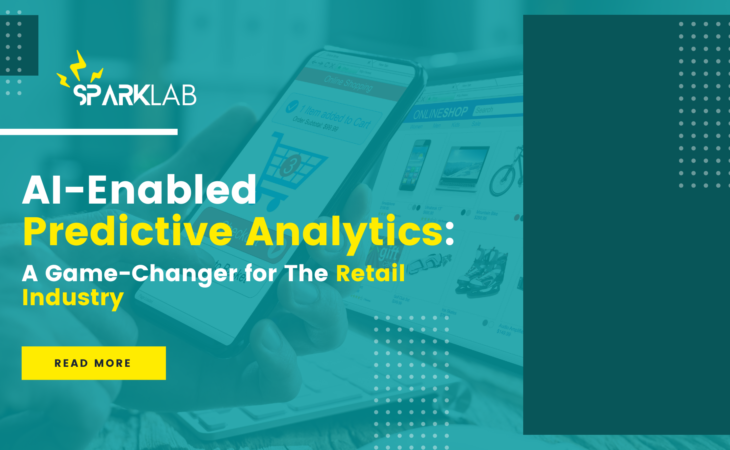
Businesses are continuously looking for innovative strategies to keep ahead of the competition in today’s dynamic and ever-changing digital market. The retail industry, in particular, faces severe competition and constantly shifting consumer needs. In the middle of these challenges, a technology known as AI-enabled predictive analytics has emerged as a game changer for retail organizations.
Predictive analytics, with its capacity to harness the power of artificial intelligence and sophisticated data analysis, is enabling retailers to anticipate customer behavior, optimize operations, and make data-driven decisions.
As part of this revolutionary influence, SparkLab also used ChatGPT to create a tool called Customer Churn Predictor. This tool gives businesses the ability to track client retention and forecast customer turnover by utilizing predictive analytics and ChatGPT’s smart algorithms. Through the use of this ground-breaking technology, organizations can proactively engage and retain customers who are at risk of leaving.
Let’s dive deep into the discussion and check out the transformative impact of AI-enabled predictive analytics in the retail sector and explore its applications, benefits, and challenges.

Predictive analytics is a subset of advanced analytics that forecasts future events using historical and real-time data, statistical algorithms, and machine learning approaches.
It extends beyond descriptive analytics, which is concerned with understanding previous occurrences, and prescriptive analytics, which is associated with recommending the optimal course of action.
Predictive analytics uses patterns and trends in data to forecast future occurrences. This allows organizations to respond to customer needs more quickly, optimize inventory management, streamline operations, and drive revenue development.

Predicting client demand accurately is critical for retailers to manage inventory levels, reduce stockouts, and improve customer happiness.
To provide accurate demand estimates, AI-enabled predictive analytics may examine historical sales data, consumer habits, seasonal patterns, and external factors like as weather and economic indicators.
Consequently, this enables businesses to manage their supply chain, align inventory levels with anticipated demand, and reduce the expenses associated with overstocking and understocking.
Understanding client preferences and behavior is critical for providing personalized experiences and marketing strategies.
Customers can be segmented using predictive analytics based on their purchasing habits, demographics, and psychographic characteristics.
Retailers may improve customer engagement and loyalty by identifying high-value customer segments and tailoring their product offerings, pricing tactics, and marketing messages to them.
Retailers may optimize pricing strategies using AI-enabled predictive analytics. This is done by assessing numerous aspects such as historical sales data, rival prices, customer behavior, and market trends.
To maximize revenue and profitability, retailers can dynamically modify prices based on demand fluctuations, competition pricing strategies, and customer feedback.
More so, this data-driven approach assists merchants in striking the proper balance of competitiveness and profitability.
Inventory management is a vital component of retail operations, and predictive analytics can increase its efficiency dramatically.
Retailers can optimize inventory levels, reduce carrying costs, prevent stockouts, and eliminate excess inventory. All of that becomes possible when the predictive models allow you to assess historical data, sales patterns, and external factors such as promotions and market trends.
This proactive approach guarantees that the right products are available at the right time, resulting in increased customer satisfaction and cost savings.

Predictive analytics enables retailers to provide personalized experiences by learning about their customers’ preferences, anticipating their needs, and making customized recommendations. This individualized approach increases consumer satisfaction, loyalty, and, as a result, sales.
Retailers may increase revenue and profitability by precisely anticipating demand, optimizing pricing tactics, and streamlining inventory management.
Predictive analytics powered by AI assists retailers in identifying new revenue opportunities, optimizing product assortments, and reducing expenses, resulting in enhanced financial performance.
Retailers can use predictive analytics to optimize numerous operational areas such as supply chain management, inventory control, and labor planning.
Retailers may streamline operations, decrease waste, and improve overall efficiency by automating manual procedures and making data-driven decisions.

While AI-enabled predictive analytics provides substantial benefits, it is critical to understand the challenges and obstacles involved:
The availability and quality of data are critical to the success of predictive analytics. For relevant insights and precise predictions, retailers must assure data accuracy, consistency, and integration from various sources.
Retailers must be responsible with customer data and address the privacy and ethical problems that come with utilizing AI. Compliance with data protection standards and ensuring consumer transparency are critical issues.
To properly collect, process, and analyze data, predictive analytics requires competent data scientists, analysts, and a robust technology infrastructure. To realize the full promise of AI-enabled predictive analytics, retailers must invest in personnel and infrastructure.
AI-enabled predictive analytics has emerged as an engine of change in the retail industry, allowing firms to anticipate customer behavior, optimize processes, and make data-driven decisions.
The emergence of novel technologies such as the Customer Churn Predictor expands the predictive analytics potential by allowing organizations to monitor customer retention and predict churn, allowing them to take proactive efforts to engage and retain consumers.
Moreover, retailers can improve the overall customer experience, boost revenue growth, and improve operational efficiency by using the power of artificial intelligence.
However, businesses must address issues such as data quality and privacy concerns. To fully realize the potential of AI-enabled predictive analytics, it is also necessary to invest in the right talent and infrastructure.
As the retail landscape evolves at a rapid pace, integrating predictive analytics becomes a strategic essential for organizations looking to achieve a competitive advantage.
So, do you think your business is ready for this amazing revolution? If so, let us know here and we’ll be more than happy to set things up for you.